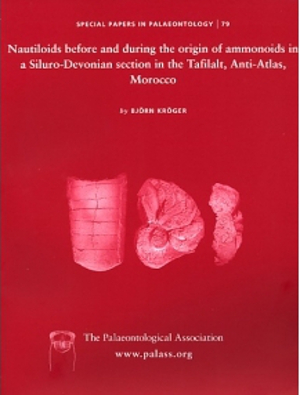Reg. Charity No. 1168330

The non-ammonoid cephalopod fauna of the Siluro-Devonian section of Filon Douze, in the southern Tafilalt, Morocco is described. The section spans a sedimentary succession of predominantly argillites with intercalated cephalopod limestones of Ludlow–Eifelian age with a thickness of c. 450 m. More than 2000 cephalopods were collected bed by bed and comprise 52 genera (17 new) and 86 species (39 new). Only one discosorid occurs, the new taxon Pseudendoplectoceras lahcani. The oncocerids are highly endemic, since out of nine recorded genera five are new: Cerovoceras, Mutoblakeoceras, Orthorizoceras, Tafilaltoceras and Ventrobalashovia. Only one of 13 oncocerid species is known from elsewhere and nine are new: Bohemojovellania adrae, B. obliquum, Brevicoceras magnum, Cerovoceras brevidomus, C. fatimi, Jovellania cheirae, Mutoblakeoceras inconstans, Tafilaltoceras adgoi and Ventrobalashovia zhuravlevae. Three actinocerids occur, two of which, Metarmenoceras fatimae and Deiroceras hollardi, are new. Within the Pseudorthoceratida the new taxa Cancellspyroceras, Geidoloceras ouaoufilalense, Subdoloceras atrouzense, S. tafilaltense, and S. engeseri, Subormoceras erfoudense and S. rissaniense are erected. The pseudorthoceratid species Neocycloceras termierorum, Spyroceras cyrtopatronus, S. latepatronus and Sulcoceras longipulchrum are also erected. New genera and species of the Orthocerida are Adiagoceras taouzense, Angeisonoceras reteornatum, Chebbioceras erfoudense, Infundibuloceras brevimira, I. longicameratum, I. mohamadi, Pseudospyroceras reticulatum, Theoceras felondouzense and Tibichoanoceras tibichoanum. Additionally, the orthoceratid species Hemicosmorthoceras aichae, Orthocycloceras tafilaltense, Plagiostomoceras lategruenwaldti, P. reticulatum, Sichuanoceras zizense and Temperoceras aequinudum, and the bactritoid species Devonobactrites emsiense are erected, and 22 species are transferred to different genera. The stratigraphical section is described in detail and the depth of deposition of key horizons is estimated. Cephalopods occur mainly in three different facies types: (1) massive limestones, silty shales and marls with a bivalve-orthocerid association, reflecting (par-)autochthonous conditions in a distal environment below storm wave base; (2) proximal tempestites with a bivalve-orthocerid association, reflecting (par-)autochthonous conditions in a distal environment above storm wave base; and (3) marls and nodular limestones containing orthocones and a diverse benthos reflecting a well-oxygenated environment below storm wave base. The bivalve-orthocerid association is exclusively pre-Pragian. The bivalve-orthocerid storm beds abruptly disappear at the top of the Lochkovian. The Pragian, Emsian and Eifelian sediments invariably contain cephalopods together with a highly diverse benthos. A significant increase in cephalopod richness and taxonomic distinctness occurs in the uppermost Lochkovian tempestites. The Lochkovian ⁄ Pragian boundary also marks a profound change in the morphological composition of the cephalopod association. In the uppermost Lochkovian several cephalopod taxa, which were adapted to the low energy needs that dominated during the late Silurian and earliest Devonian, have their last occurrence. In post-Lochkovian strata cephalopod morphotypes that were adapted to energy-intensive buoyancy regulation dominate. Finally, in late Pragian and Zlíchovian deposits, bactritoids sensu stricto, ammonoids, coiled nautiloids and several pseudorthocerids have their first occurrence. These groups dominated in the late Palaeozoic. Therefore, the changes at the Lochkovian ⁄ Pragian boundary resulting in better conditions for life on the seafloor can be interpreted as a precondition that led to the landmark evolutionary innovations in the Zlíchovian.